FastTrack Training. "Network Basics". "The Basics of Telephony." Part 2. Eddie Martin. December 2012
About a year ago, I noticed an interesting and fascinating series of lectures by Eddie Martin, which, thanks to its history and real-life examples, as well as its tremendous learning experience, is amazingly comprehensible and allows you to gain an understanding of quite complex technologies.
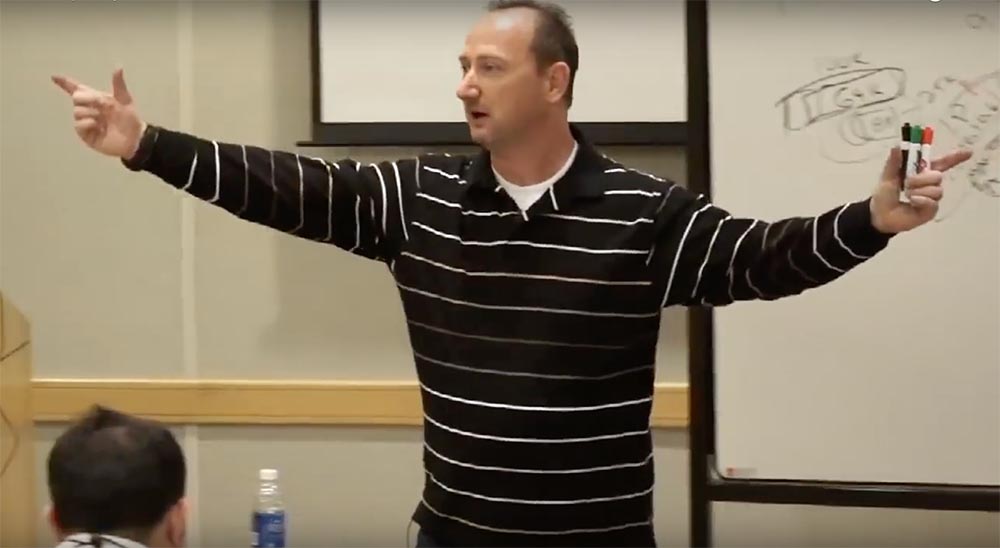
We continue the cycle of 27 articles based on his lectures:
')
01/02: “Understanding the OSI Model” Part 1 / Part 2
03: "Understanding the Cisco Architecture"
04/05: “The Basics of Switching or Switches” Part 1 / Part 2
06: "Switches from Cisco"
07: "Area of use of network switches, the value of Cisco switches"
08/09: "Basics of a Wireless LAN" Part 1 / Part 2
10: "Products in the field of wireless LAN"
11: The Value of Cisco Wireless LANs
12: Routing Basics
13: "The structure of routers, routing platforms from Cisco"
14: The Value of Cisco Routers
15/16: “The Basics of Data Centers” Part 1 / Part 2
17: "Equipment for data centers"
18: "The Value of Cisco in Data Centers"
19/20/21: "The Basics of Telephony" Part 1 / Part 2 / Part 3
22: "Cisco Collaboration Software"
23: The Value of Collaboration Products from Cisco
24: "The Basics of Security"
25: "Cisco Security Software"
26: "The Value of Cisco Security Products"
27: "Understanding Cisco Architectural Games (Review)"
And here is the twentieth of them.
We broadcast the voice using applications and we are committed to ensuring the operation of customer applications. Cisco did not know anything about PBX, so when we explained the advantage of our telephony, we first of all pointed to the highest reliability. Our equipment had phenomenal resiliency - 99.999%. This means that Cisco equipment downtime did not exceed 5 minutes per year! But what is considered downtime in telephony?
Having created VoIP, we opened the whole world to users. If we return to the issues of reliability, there are several interesting features.
Let 24 phones be connected to one of the maps of our station (left lower segment). There are 600 such stations in my PBX. If one such card for 24 phones fails, will it be considered a system downtime?

Where is the starting point, after which you can tell whether the system is working or not, how fault tolerant it is, what percentage of its reliability? So, classical telephony was considered inoperative if 30% of its infrastructure became inaccessible. Suppose your day started badly, on the way to work you were stopped and fined by a policeman, then your wife called and announced that she was divorcing you. You have a disgusting mood, you have ripped out the phone card in your hearts and disabled 24 phones. Is this a system crash? Of course not. If you have 600 such stations, then in order for the system to be considered inoperable, you must get rid of 30% - these are 180 stations. That's what a system crash means.
But an ordinary Cisco employee did not know about all this, and we made a lot of mistakes, trying to overcome competitors, until we found the best way. You know, people still do not see the difference between IP telephony and VoIP technology. They do not understand that the difference lies in the fact that we do not just transmit the voice, but turn it into an app! We just had to do something about it. In 2001, customers became interested in our technology, and 2002 was a really good year for us. There was a recession in the country, but we managed to sell a lot of our products. Let me remind you that in 2000, Nortel was the leader in the field of networks, and the primacy of production on the market was for Avaya. But in 2009, number 1 became Cisco. For the market it is a very short period, and during this time we were able to change the world.
We did not specialize in the production of equipment specifically for offices, but we have a series of switches 6000 Business Edition, designed for small companies. I will digress a little from the topic and give one example. Customers often told me that they do not need voice mail. Do you think my daughter Emily uses voice mail? No, she never responds to voice messages. This suggests that the rules of the game are changing. We need to intensify the development of the changes in technology that really interest people in our time. We have to make new clients come to us.
Regarding my drawing, we need to know and explain to our customers the role of Cisco in this area. We introduced our technologies and thereby stimulated the entire telephony market. We switched to IP technology and all this “hardware” is a thing of the past. A little later we will talk about HCS, a hierarchical cellular structure.
And now let's talk about what kind of solutions from Cisco have. I have already told you that since I am not very smart, I like to simplify everything. Therefore, we consider solutions from three sides - services, customers, and infrastructure.
Services represent a set of network software and applications with which one or another type of client interacts, and the infrastructure will depend on what these clients need for their work.
A typical solution is a switch with which an IP phone is connected using PoE. The last word "telephone" as a physical device should disappear. It is not necessary in this technology, but people continue to use telephone sets. So in reality, the IP phone is not a phone at all, but a client. After all, we have a personal computer PC, where you can put this client. This is the Jabber client.
Further - what service does our switch need, what software does it need? He needs a CM communication manager.

Our phone has the IP address 10.10.10.6 and the MAC address A. How do we connect the phone with the CM manager? You need to put the MAC address of our phone there. That is, the CM is a database with tables of all components. This table contains MAC addresses, EXT extensions for mobility, that is, passwords and logins, and telephone functions. And by the way, when the phone communicates with the CM, he sends him his IP address. Thanks to this, you can transfer your phone to anywhere and connect to the network wherever you want.

Our computer has a MAC address B and an IP address 11.11.11.9. We also enter this data in the CM table.
I pick up the phone, or press a button, and my IP phone sends one package to the CM. This starts recording call details, or CDR (Call Detail Record). It allows you to track this call, to see that the call is happening. The CM manager sends another packet to the phone - this is a dial tone that tells the customer that the phone is working. Suppose our phone has the extension number 3000, and the computer, or rather, its Jabber client is 3200. The call from the phone goes to the CM, which according to the table determines the extension of the device with the number 3200 and finds its IP address, then sends the call to the computer. And the computer starts to ring like a regular phone, indicating that someone is calling its owner. Both the “hardware” and the “softphone” phone react equally to the incoming call - they both produce ringing noise. The communication manager organizes a direct conversation between network clients, two RTP poktok, in both directions. They do not go through it, it only organizes it. When one of the subscribers hangs up, the signal goes to CM and it stops recording CDRs, and the customers' phones switch to normal mode. This is how it works - it's not rocket science.
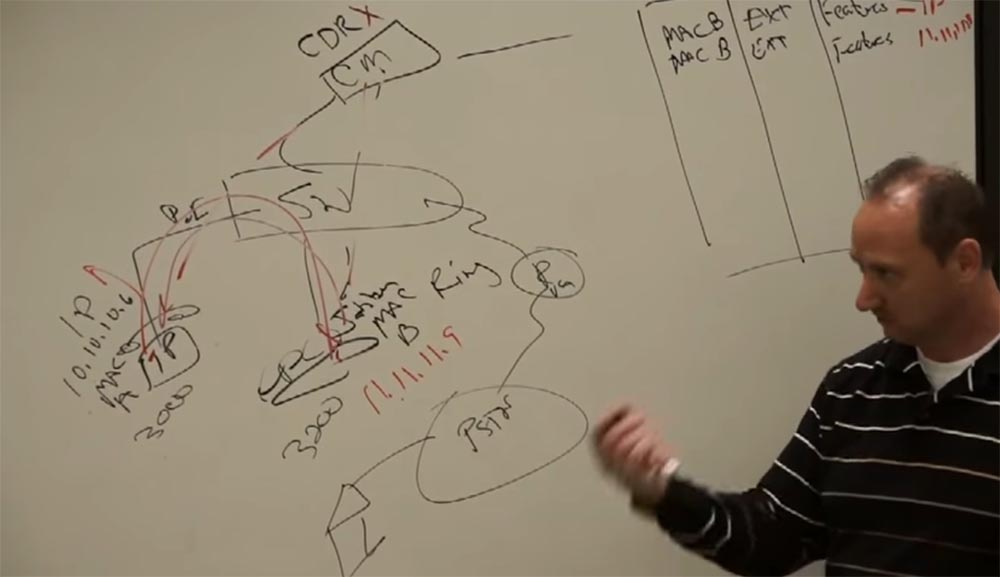
What happens if I want to call someone who is outside our network? I will draw here a VG voice gate router, which is connected to the PSTN, and the one with the subscriber's home phone.
Suppose I want to call my wife to find out if her dog has eaten something else. Two days ago, when I put my things downstairs, she was going through my hat, my favorite hat. Never before has a wife's dog been so close to death. I pick up the phone, the signal comes in CM, then I dial my home number, the CM checks it on the table - oh, this is an outside call! And refers to the switch. He contacts a router that has its own IP address, and the router sends the called phone number to the PSTN, and then the city network calls my wife to the phone. Calls via Wi-Fi do the same, because it’s the same network.
I will tell you the important thing that I always tell my clients. All these things did classic telephone exchanges, but the problem was that the PBX was literally crammed with different equipment, a bunch of cards with different functions. Therefore, it was very difficult to achieve fail-safe collaboration of all this “hardware”, it was too much.
We proposed a solution whereby a call performs 17 steps before connecting two subscribers, but thanks to protocols and applications, this happens on a minimal amount of hardware. We proceeded from the principle “do not make something that can be simplified complicated”. We did not have a server for selected clients, but a server for absolutely everyone.
The table located in the CM, is a phone book. We all used them once. The last time I used the phone book was when I needed a target for an air rifle. It was convenient to shoot at her, and she was the cheapest target.
People ask me if Microsoft played any role in the development of IP telephony. This refers to software for telephone calls through a computer. Undoubtedly, since Microsoft is developing software, they took part in this, created a client-server emulator. As they say, it's hard not to notice the elephant in the room. However, in 2001, when we were engaged in IP telephony, Microsoft had nothing to do with it. They picked up the technology and were forced to create software for computers with the function of calls already on the fact of the existence of IP-telephony.
Here, our representative from Australia is present in the hall, and I note that more IP telephony systems are now being sold in Australia than anywhere else in the world. In North America, about 60% of telephone systems sold are based on IP solutions, 40% of which are Cisco products. But I want to ask you to be careful with these numbers - the number of IP phones does not match the number of telephone numbers. For example, a client has 25 IP phones and 560 regular telephones, these are different numbers. So be careful when telling customers about these numbers.
Expand our scheme. I’ll add a WAN to our router, then another 1 router connected also to the PSTN, then put the switch and attach an IP phone to it.
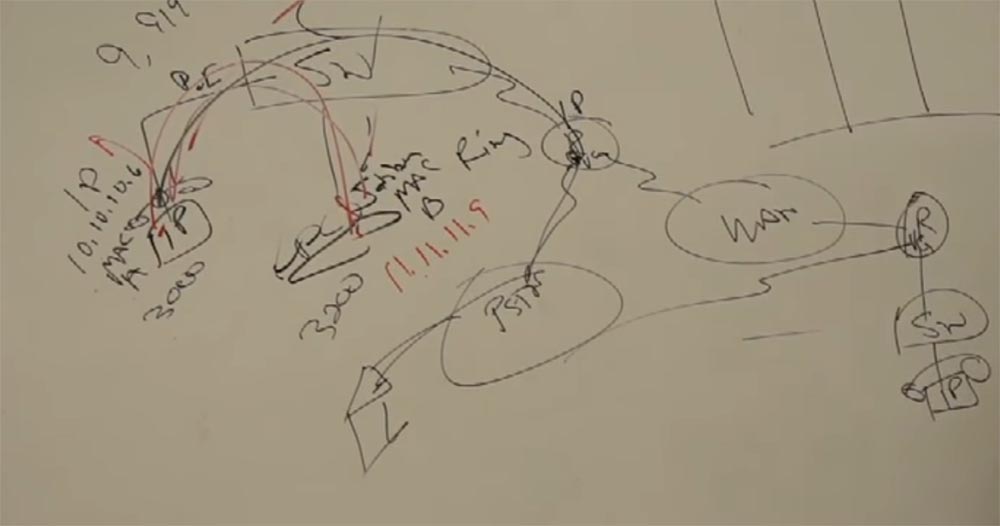
This phone does not need a separate PBX. His data is entered in the CM table and he becomes a full-fledged element of our network. Suppose it has code 4000. I pick up my phone with code 3000 and call my friend, that is, call number 4000. And the CM ensures that my IP phone “talks” to my friend's IP phone, that is, connects two IP together. At the same time, we have a choice - I can contact this number via PSTN or send a call via WAN. I have two different networks and I can choose the one that suits me better.
In the case of WAN, we have bandwidth limitations. Remember how I painted pipes of different diameters: a wide pipe, a narrow tube, a wide pipe again. My IP phone encapsulates voice, turns it into data and uses a 64 kbps channel. More service information is added to the outgoing packet, and I receive a 100 Kbps packet for 1 second of the call. For LAN equipment, this is a negligible amount. But for a WAN whose bandwidth is 2 Mbps, this value does not seem too small. Therefore, we use codecs that pack a voice call of only 8 Kbps, and we get a packet size 4 times smaller - only 25 Kbps for 1 second call. This reduces the load on the WAN.
Our SM communications manager should ask the router if the router can pass a call through the WAN. Why is this done? Because the router controls this bridge between the system and the WAN. And administrative control of calls is becoming more and more important. After all, we want to transmit not only voice, but also video and other data.
So, if the router allows you to skip a call, the CM informs our phone at the system entrance that the call needs to be recoded into a lowered bitrate of 8 Kbps, because it will pass through the WAN, which has a limited bandwidth. This is how the system works, which connects a telephone with code 3000 and a telephone with code 4000.

This technology is provided by the routing protocol used by the router. CM allows you to simultaneously send 6 calls over the network. In total, the system uses 4 different protocols that provide call transfer.
How many phones or video devices can be connected to one CM communication manager? 40 thousand devices! In this case, we have a limitation determined by server capabilities. Cisco, as a very good engineering company, has documentation that tells the user about the possibilities of a cluster solution and how to combine hundreds of such servers into one IP solution. That is, you have the potential to connect 4 million phones to the same network, which is provided by Cisco technical support. We have several such clusters in India, in Europe, in North America and so on.
Now let's talk about clusters. The first CM you have configured is called Publisher - Publisher. He owns the database. I want to have redundancy here for fault tolerance, right? And therefore we have a second CM, Subscriber - Subscriber, and this manager receives data from Publisher. When you download this system, CM asks Publisher or Subscriber it. The first can do anything, read, write. But Subscriber immediately asks where is my Publisher? These devices are separated so that our database remains consistent, provides fault tolerance. The database can be hosted both on an independent server and on a virtual one, and the CM is a device that can request this database and use it for its own needs. Let me remind you that all of these servers are software applications. They are delivered to the user on CDs, like any other software, and can be virtualized.
So Publisher owns the information, and Subscriber uses it. How far from the Publisher can the Subscriber be located? Are they in the same general building?
The requirements stipulate a time of 80 milliseconds for the mutual exchange of data between the two devices.
I will give you an example. North America is a big enough continent, big enough for me, especially when you fly across the whole continent often. I worked in Telus, Canada, and we talked about technology opportunities. And they told me that they are able to provide information from Halifax, Nova Scotia, and this is at the other end of the continent, to Calgary for 80 ms and the stated throughput. So I can place my Publisher in Calgary, and Subscriber in Halifax at a distance of of the length of the continent, and such a speed of communication between them will be guaranteed.
So, Publisher and Subscriber form a cluster. A cluster may consist of two or more SM communication managers using a common database.
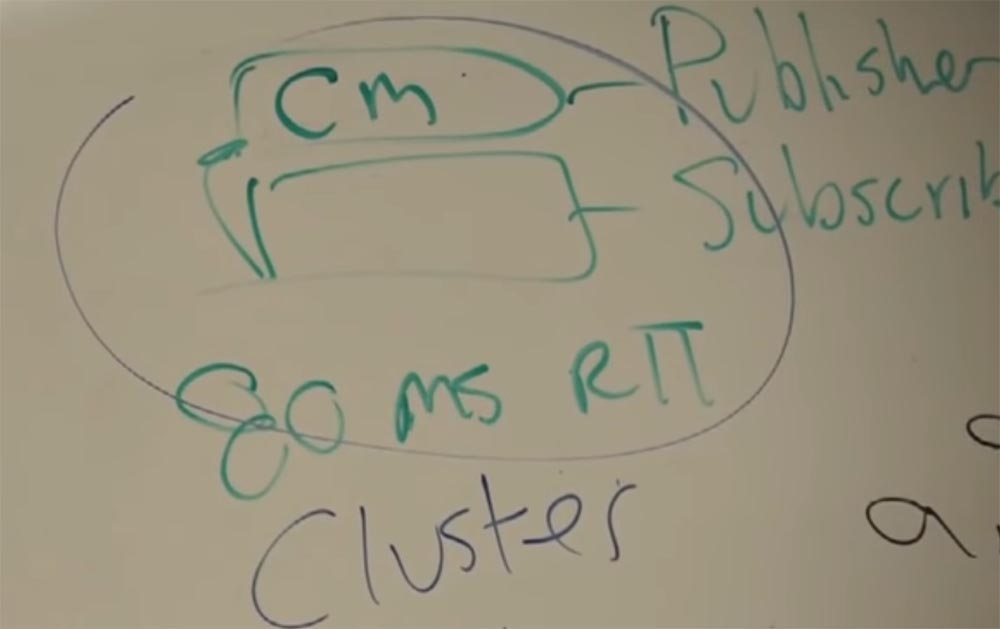
In one cluster, you can combine 20 servers. What should you buy by downloading CM Communication Manager software? Only user license! You do not need to buy any additional physical devices.
If you use UCS, a Cisco server platform, then install the new server software from an existing equipment under a license. You can buy 20 or 50 licenses and connect the corresponding number of users to the network. You simply upload a new CM to an existing server and launch it. This solution is based on VMware technology. On the basis of Linux, a virtual machine is created that organizes a virtual network. A guide to deploying such a network consists of 1200 pages, and absolutely all the principles and steps are described there. To create such networks, Cisco C Series equipment is used, but IBM servers and other products with which our equipment is compatible can be used.
The license enters the CM, which performs all the actions stipulated by this license. Users can even choose their phone numbers, if required by the license.
We do not need telephonists in their classic sense, but there are external technical specialists in client companies who deal with IP telephony.
I want to return again in the years 2000-2001, when we just entered the market with our technology. Then we used the SCCP protocol, and now SIP - perhaps this is the whole difference with the configuration of 2001.
Consider what happens if a WAN goes down - so I’ve crossed it off.

We will have a client who does not see his server. It will not have a data transfer path to the server.
Suppose your home server has disappeared. The Internet has disconnected, and when you open Outlook or another email client, you cannot send an email. So, the connection manager, as soon as he sees that the connection with any client IP has disappeared, immediately reports that the WAN has failed. However, we cannot risk the business of our clients. Therefore, Cisco in less than 3.5 months has created a special software for the router called SRST - “invulnerable remote telephone communication” - which shows that our equipment has much greater capabilities than one can imagine.
We have been using this system since 2001 - look at how it looks in the picture.

You can call from the branch (top left phone) to headquarters (right bottom phone), talk to a friend (bottom left phone) or order a pizza in the city. In the first case, the call will go through IP WAN, in the second - directly over the branch's local network connecting the upper and lower phones, and in the third case via the public PSTN telephone network. Suppose that the connection with the IP WAN is interrupted.

Upon discovering this, the branch server will make 3 attempts to contact the subscriber at headquarters. If this fails, he will direct the call to bypass the WAN via the PSTN and then to the headquarters router. We have been using this method of ensuring reliable communication since 2001. This has become possible because in our IP telephony system, PSTN and IP WAN are separate and can operate independently. This is not in the classical telephone network, so it is less reliable.
Keep in mind that our customers do not resemble each other. For example, one needs voice mail, others do not, and this should be taken into account. To use voice mail on your business phone, use the open XMPP Jabber protocol. Customer needs change over time.
, , , communication manager, , . . , VG. DSP, .
: IP-, MAC c Jabber, iPad, iPhone Android. Jabber-.
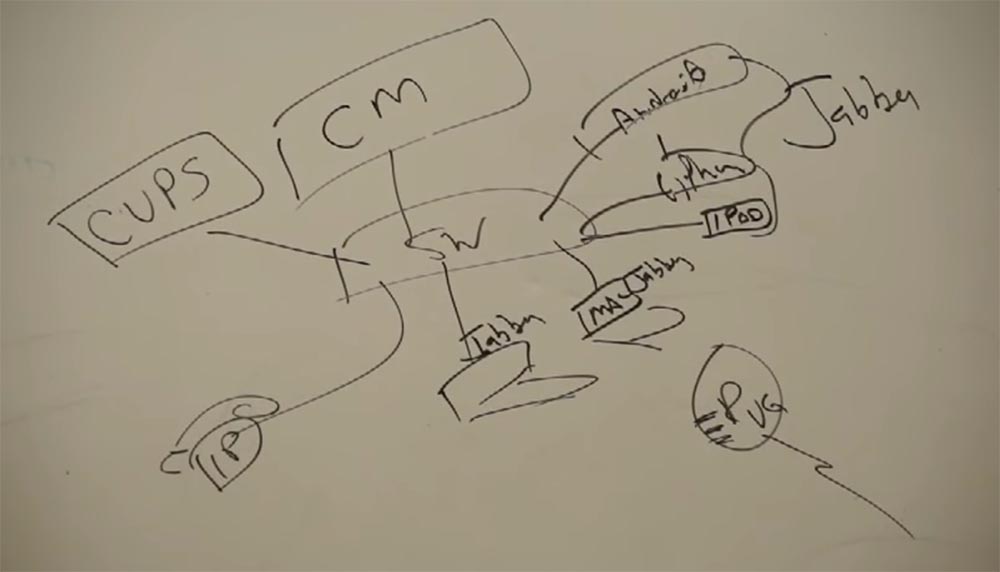
. CM .
, , – CUPS — Cisco Unified Presene Server. , .
, CUPS , . .
Cisco – CUC, Cisco Unity Connection. , .
- , , CUC, , .
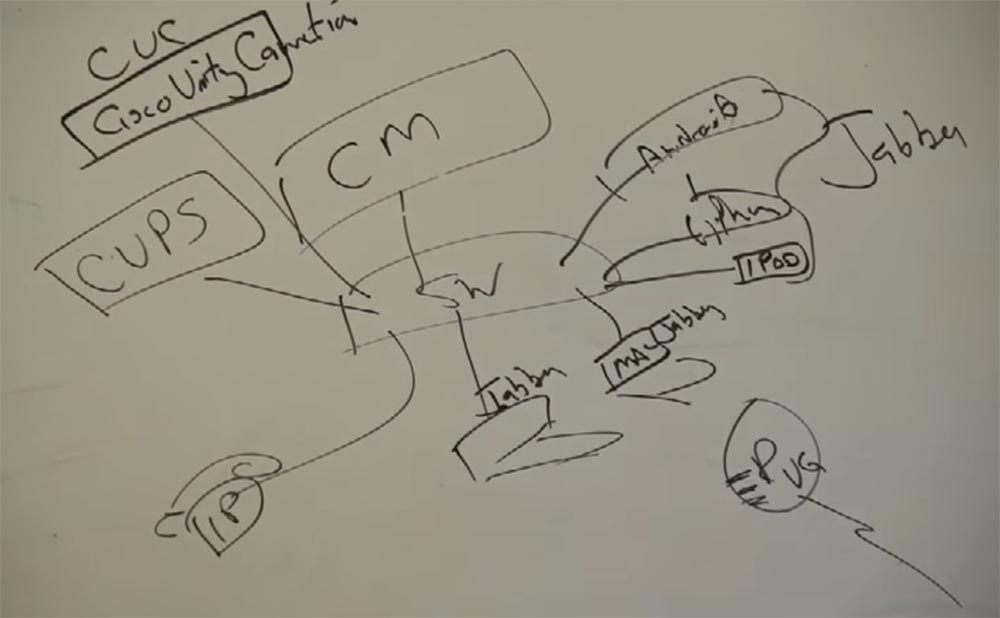
– UCS. , , .
. , , , .
, , Wi-Fi , . Jabber , , AnyConnect. VPN-.
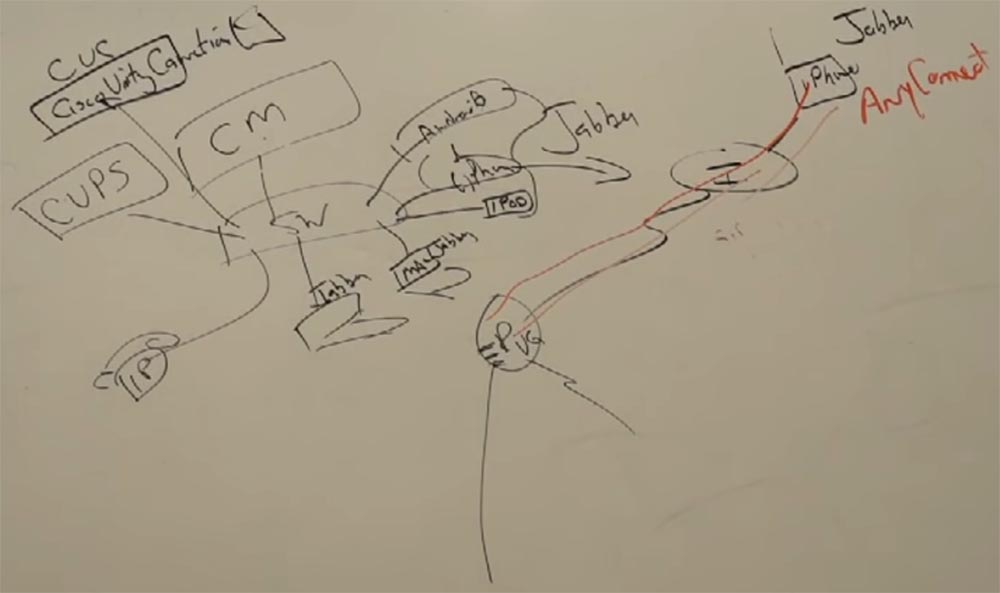
: , «», . Cisco, VPN, .
CUPS , CUC. , , . IP-, , .
30- , 31 , .
.
, , .
Thank you for staying with us. Do you like our articles? Want to see more interesting materials? Support us by placing an order or recommending to friends, 30% discount for Habr users on a unique analogue of the entry-level servers that we invented for you: The Truth About VPS (KVM) E5-2650 v4 (6 Cores) 10GB DDR4 240GB SSD 1Gbps $ 20 or how to share the server? (Options are available with RAID1 and RAID10, up to 24 cores and up to 40GB DDR4).
Dell R730xd 2 times cheaper? Only we have 2 x Intel Dodeca-Core Xeon E5-2650v4 128GB DDR4 6x480GB SSD 1Gbps 100 TV from $ 249 in the Netherlands and the USA! Read about How to build an infrastructure building. class c using servers Dell R730xd E5-2650 v4 worth 9000 euros for a penny?

We continue the cycle of 27 articles based on his lectures:
')
01/02: “Understanding the OSI Model” Part 1 / Part 2
03: "Understanding the Cisco Architecture"
04/05: “The Basics of Switching or Switches” Part 1 / Part 2
06: "Switches from Cisco"
07: "Area of use of network switches, the value of Cisco switches"
08/09: "Basics of a Wireless LAN" Part 1 / Part 2
10: "Products in the field of wireless LAN"
11: The Value of Cisco Wireless LANs
12: Routing Basics
13: "The structure of routers, routing platforms from Cisco"
14: The Value of Cisco Routers
15/16: “The Basics of Data Centers” Part 1 / Part 2
17: "Equipment for data centers"
18: "The Value of Cisco in Data Centers"
19/20/21: "The Basics of Telephony" Part 1 / Part 2 / Part 3
22: "Cisco Collaboration Software"
23: The Value of Collaboration Products from Cisco
24: "The Basics of Security"
25: "Cisco Security Software"
26: "The Value of Cisco Security Products"
27: "Understanding Cisco Architectural Games (Review)"
And here is the twentieth of them.
FastTrack Training. "Network Basics". "The Basics of Telephony." Part 2. Eddie Martin. December 2012
We broadcast the voice using applications and we are committed to ensuring the operation of customer applications. Cisco did not know anything about PBX, so when we explained the advantage of our telephony, we first of all pointed to the highest reliability. Our equipment had phenomenal resiliency - 99.999%. This means that Cisco equipment downtime did not exceed 5 minutes per year! But what is considered downtime in telephony?
Having created VoIP, we opened the whole world to users. If we return to the issues of reliability, there are several interesting features.
Let 24 phones be connected to one of the maps of our station (left lower segment). There are 600 such stations in my PBX. If one such card for 24 phones fails, will it be considered a system downtime?

Where is the starting point, after which you can tell whether the system is working or not, how fault tolerant it is, what percentage of its reliability? So, classical telephony was considered inoperative if 30% of its infrastructure became inaccessible. Suppose your day started badly, on the way to work you were stopped and fined by a policeman, then your wife called and announced that she was divorcing you. You have a disgusting mood, you have ripped out the phone card in your hearts and disabled 24 phones. Is this a system crash? Of course not. If you have 600 such stations, then in order for the system to be considered inoperable, you must get rid of 30% - these are 180 stations. That's what a system crash means.
But an ordinary Cisco employee did not know about all this, and we made a lot of mistakes, trying to overcome competitors, until we found the best way. You know, people still do not see the difference between IP telephony and VoIP technology. They do not understand that the difference lies in the fact that we do not just transmit the voice, but turn it into an app! We just had to do something about it. In 2001, customers became interested in our technology, and 2002 was a really good year for us. There was a recession in the country, but we managed to sell a lot of our products. Let me remind you that in 2000, Nortel was the leader in the field of networks, and the primacy of production on the market was for Avaya. But in 2009, number 1 became Cisco. For the market it is a very short period, and during this time we were able to change the world.
We did not specialize in the production of equipment specifically for offices, but we have a series of switches 6000 Business Edition, designed for small companies. I will digress a little from the topic and give one example. Customers often told me that they do not need voice mail. Do you think my daughter Emily uses voice mail? No, she never responds to voice messages. This suggests that the rules of the game are changing. We need to intensify the development of the changes in technology that really interest people in our time. We have to make new clients come to us.
Regarding my drawing, we need to know and explain to our customers the role of Cisco in this area. We introduced our technologies and thereby stimulated the entire telephony market. We switched to IP technology and all this “hardware” is a thing of the past. A little later we will talk about HCS, a hierarchical cellular structure.
And now let's talk about what kind of solutions from Cisco have. I have already told you that since I am not very smart, I like to simplify everything. Therefore, we consider solutions from three sides - services, customers, and infrastructure.
Services represent a set of network software and applications with which one or another type of client interacts, and the infrastructure will depend on what these clients need for their work.
A typical solution is a switch with which an IP phone is connected using PoE. The last word "telephone" as a physical device should disappear. It is not necessary in this technology, but people continue to use telephone sets. So in reality, the IP phone is not a phone at all, but a client. After all, we have a personal computer PC, where you can put this client. This is the Jabber client.
Further - what service does our switch need, what software does it need? He needs a CM communication manager.

Our phone has the IP address 10.10.10.6 and the MAC address A. How do we connect the phone with the CM manager? You need to put the MAC address of our phone there. That is, the CM is a database with tables of all components. This table contains MAC addresses, EXT extensions for mobility, that is, passwords and logins, and telephone functions. And by the way, when the phone communicates with the CM, he sends him his IP address. Thanks to this, you can transfer your phone to anywhere and connect to the network wherever you want.

Our computer has a MAC address B and an IP address 11.11.11.9. We also enter this data in the CM table.
I pick up the phone, or press a button, and my IP phone sends one package to the CM. This starts recording call details, or CDR (Call Detail Record). It allows you to track this call, to see that the call is happening. The CM manager sends another packet to the phone - this is a dial tone that tells the customer that the phone is working. Suppose our phone has the extension number 3000, and the computer, or rather, its Jabber client is 3200. The call from the phone goes to the CM, which according to the table determines the extension of the device with the number 3200 and finds its IP address, then sends the call to the computer. And the computer starts to ring like a regular phone, indicating that someone is calling its owner. Both the “hardware” and the “softphone” phone react equally to the incoming call - they both produce ringing noise. The communication manager organizes a direct conversation between network clients, two RTP poktok, in both directions. They do not go through it, it only organizes it. When one of the subscribers hangs up, the signal goes to CM and it stops recording CDRs, and the customers' phones switch to normal mode. This is how it works - it's not rocket science.

What happens if I want to call someone who is outside our network? I will draw here a VG voice gate router, which is connected to the PSTN, and the one with the subscriber's home phone.
Suppose I want to call my wife to find out if her dog has eaten something else. Two days ago, when I put my things downstairs, she was going through my hat, my favorite hat. Never before has a wife's dog been so close to death. I pick up the phone, the signal comes in CM, then I dial my home number, the CM checks it on the table - oh, this is an outside call! And refers to the switch. He contacts a router that has its own IP address, and the router sends the called phone number to the PSTN, and then the city network calls my wife to the phone. Calls via Wi-Fi do the same, because it’s the same network.
I will tell you the important thing that I always tell my clients. All these things did classic telephone exchanges, but the problem was that the PBX was literally crammed with different equipment, a bunch of cards with different functions. Therefore, it was very difficult to achieve fail-safe collaboration of all this “hardware”, it was too much.
We proposed a solution whereby a call performs 17 steps before connecting two subscribers, but thanks to protocols and applications, this happens on a minimal amount of hardware. We proceeded from the principle “do not make something that can be simplified complicated”. We did not have a server for selected clients, but a server for absolutely everyone.
The table located in the CM, is a phone book. We all used them once. The last time I used the phone book was when I needed a target for an air rifle. It was convenient to shoot at her, and she was the cheapest target.
People ask me if Microsoft played any role in the development of IP telephony. This refers to software for telephone calls through a computer. Undoubtedly, since Microsoft is developing software, they took part in this, created a client-server emulator. As they say, it's hard not to notice the elephant in the room. However, in 2001, when we were engaged in IP telephony, Microsoft had nothing to do with it. They picked up the technology and were forced to create software for computers with the function of calls already on the fact of the existence of IP-telephony.
Here, our representative from Australia is present in the hall, and I note that more IP telephony systems are now being sold in Australia than anywhere else in the world. In North America, about 60% of telephone systems sold are based on IP solutions, 40% of which are Cisco products. But I want to ask you to be careful with these numbers - the number of IP phones does not match the number of telephone numbers. For example, a client has 25 IP phones and 560 regular telephones, these are different numbers. So be careful when telling customers about these numbers.
Expand our scheme. I’ll add a WAN to our router, then another 1 router connected also to the PSTN, then put the switch and attach an IP phone to it.

This phone does not need a separate PBX. His data is entered in the CM table and he becomes a full-fledged element of our network. Suppose it has code 4000. I pick up my phone with code 3000 and call my friend, that is, call number 4000. And the CM ensures that my IP phone “talks” to my friend's IP phone, that is, connects two IP together. At the same time, we have a choice - I can contact this number via PSTN or send a call via WAN. I have two different networks and I can choose the one that suits me better.
In the case of WAN, we have bandwidth limitations. Remember how I painted pipes of different diameters: a wide pipe, a narrow tube, a wide pipe again. My IP phone encapsulates voice, turns it into data and uses a 64 kbps channel. More service information is added to the outgoing packet, and I receive a 100 Kbps packet for 1 second of the call. For LAN equipment, this is a negligible amount. But for a WAN whose bandwidth is 2 Mbps, this value does not seem too small. Therefore, we use codecs that pack a voice call of only 8 Kbps, and we get a packet size 4 times smaller - only 25 Kbps for 1 second call. This reduces the load on the WAN.
Our SM communications manager should ask the router if the router can pass a call through the WAN. Why is this done? Because the router controls this bridge between the system and the WAN. And administrative control of calls is becoming more and more important. After all, we want to transmit not only voice, but also video and other data.
So, if the router allows you to skip a call, the CM informs our phone at the system entrance that the call needs to be recoded into a lowered bitrate of 8 Kbps, because it will pass through the WAN, which has a limited bandwidth. This is how the system works, which connects a telephone with code 3000 and a telephone with code 4000.

This technology is provided by the routing protocol used by the router. CM allows you to simultaneously send 6 calls over the network. In total, the system uses 4 different protocols that provide call transfer.
How many phones or video devices can be connected to one CM communication manager? 40 thousand devices! In this case, we have a limitation determined by server capabilities. Cisco, as a very good engineering company, has documentation that tells the user about the possibilities of a cluster solution and how to combine hundreds of such servers into one IP solution. That is, you have the potential to connect 4 million phones to the same network, which is provided by Cisco technical support. We have several such clusters in India, in Europe, in North America and so on.
Now let's talk about clusters. The first CM you have configured is called Publisher - Publisher. He owns the database. I want to have redundancy here for fault tolerance, right? And therefore we have a second CM, Subscriber - Subscriber, and this manager receives data from Publisher. When you download this system, CM asks Publisher or Subscriber it. The first can do anything, read, write. But Subscriber immediately asks where is my Publisher? These devices are separated so that our database remains consistent, provides fault tolerance. The database can be hosted both on an independent server and on a virtual one, and the CM is a device that can request this database and use it for its own needs. Let me remind you that all of these servers are software applications. They are delivered to the user on CDs, like any other software, and can be virtualized.
So Publisher owns the information, and Subscriber uses it. How far from the Publisher can the Subscriber be located? Are they in the same general building?
The requirements stipulate a time of 80 milliseconds for the mutual exchange of data between the two devices.
I will give you an example. North America is a big enough continent, big enough for me, especially when you fly across the whole continent often. I worked in Telus, Canada, and we talked about technology opportunities. And they told me that they are able to provide information from Halifax, Nova Scotia, and this is at the other end of the continent, to Calgary for 80 ms and the stated throughput. So I can place my Publisher in Calgary, and Subscriber in Halifax at a distance of of the length of the continent, and such a speed of communication between them will be guaranteed.
So, Publisher and Subscriber form a cluster. A cluster may consist of two or more SM communication managers using a common database.

In one cluster, you can combine 20 servers. What should you buy by downloading CM Communication Manager software? Only user license! You do not need to buy any additional physical devices.
If you use UCS, a Cisco server platform, then install the new server software from an existing equipment under a license. You can buy 20 or 50 licenses and connect the corresponding number of users to the network. You simply upload a new CM to an existing server and launch it. This solution is based on VMware technology. On the basis of Linux, a virtual machine is created that organizes a virtual network. A guide to deploying such a network consists of 1200 pages, and absolutely all the principles and steps are described there. To create such networks, Cisco C Series equipment is used, but IBM servers and other products with which our equipment is compatible can be used.
The license enters the CM, which performs all the actions stipulated by this license. Users can even choose their phone numbers, if required by the license.
We do not need telephonists in their classic sense, but there are external technical specialists in client companies who deal with IP telephony.
I want to return again in the years 2000-2001, when we just entered the market with our technology. Then we used the SCCP protocol, and now SIP - perhaps this is the whole difference with the configuration of 2001.
Consider what happens if a WAN goes down - so I’ve crossed it off.

We will have a client who does not see his server. It will not have a data transfer path to the server.
Suppose your home server has disappeared. The Internet has disconnected, and when you open Outlook or another email client, you cannot send an email. So, the connection manager, as soon as he sees that the connection with any client IP has disappeared, immediately reports that the WAN has failed. However, we cannot risk the business of our clients. Therefore, Cisco in less than 3.5 months has created a special software for the router called SRST - “invulnerable remote telephone communication” - which shows that our equipment has much greater capabilities than one can imagine.
We have been using this system since 2001 - look at how it looks in the picture.

You can call from the branch (top left phone) to headquarters (right bottom phone), talk to a friend (bottom left phone) or order a pizza in the city. In the first case, the call will go through IP WAN, in the second - directly over the branch's local network connecting the upper and lower phones, and in the third case via the public PSTN telephone network. Suppose that the connection with the IP WAN is interrupted.

Upon discovering this, the branch server will make 3 attempts to contact the subscriber at headquarters. If this fails, he will direct the call to bypass the WAN via the PSTN and then to the headquarters router. We have been using this method of ensuring reliable communication since 2001. This has become possible because in our IP telephony system, PSTN and IP WAN are separate and can operate independently. This is not in the classical telephone network, so it is less reliable.
Keep in mind that our customers do not resemble each other. For example, one needs voice mail, others do not, and this should be taken into account. To use voice mail on your business phone, use the open XMPP Jabber protocol. Customer needs change over time.
, , , communication manager, , . . , VG. DSP, .
: IP-, MAC c Jabber, iPad, iPhone Android. Jabber-.

. CM .
, , – CUPS — Cisco Unified Presene Server. , .
, CUPS , . .
Cisco – CUC, Cisco Unity Connection. , .
- , , CUC, , .

– UCS. , , .
. , , , .
, , Wi-Fi , . Jabber , , AnyConnect. VPN-.

: , «», . Cisco, VPN, .
CUPS , CUC. , , . IP-, , .
30- , 31 , .
.
, , .
Thank you for staying with us. Do you like our articles? Want to see more interesting materials? Support us by placing an order or recommending to friends, 30% discount for Habr users on a unique analogue of the entry-level servers that we invented for you: The Truth About VPS (KVM) E5-2650 v4 (6 Cores) 10GB DDR4 240GB SSD 1Gbps $ 20 or how to share the server? (Options are available with RAID1 and RAID10, up to 24 cores and up to 40GB DDR4).
Dell R730xd 2 times cheaper? Only we have 2 x Intel Dodeca-Core Xeon E5-2650v4 128GB DDR4 6x480GB SSD 1Gbps 100 TV from $ 249 in the Netherlands and the USA! Read about How to build an infrastructure building. class c using servers Dell R730xd E5-2650 v4 worth 9000 euros for a penny?
Source: https://habr.com/ru/post/351294/
All Articles